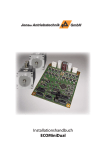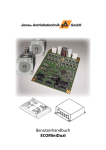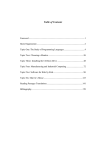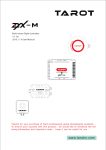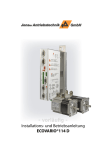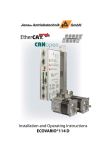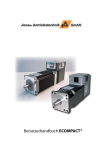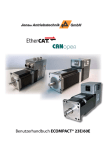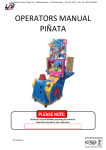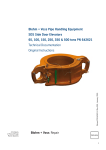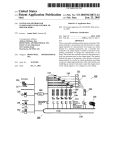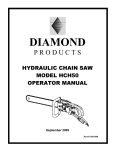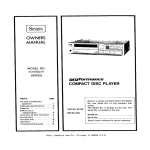Download Installation Manual ECOMiniDual
Transcript
Installation Manual ECOMiniDual Installation Manual ECOMiniDual Published editions: Edition Comment July 2009 Preliminary English edition (prototype deliveries) March 2010 Series availability, option protective housing May 2012 Modification of default cable set August 2012 Modfication concerning loop-through of supply voltage XP1, XP2 All rights reserved: Jenaer Antriebstechnik GmbH Buchaer Straße 1 07745 Jena No parts of this documentation may be translated, reprinted or reproducted on microfilm or in other ways without written permission by Jenaer Antriebstechnik GmbH. The content of this document has been worked out and checked carefully. Nevertheless differences from the real state of the hard and software can never be fully excluded. Necessary corrections will be carried out in the next edition. ECOVARIO® is a registered trademark of Jenaer Antriebstechnik GmbH, Jena. CANopen® is a registered community trademark of CAN in Automation e.V., Nuremberg. Windows® is a registered trademark of Microsoft Corporation in the United States and other countries. Subject to change without notice! 3 Installation Manual ECOMiniDual 4 Subject to change without notice! Installation Manual ECOMiniDual Contents 1 About this documentation............................................................................................................. 7 2 2.1 2.2 2.3 2.4 2.5 Safety instructions ......................................................................................................................... 7 Symbols ......................................................................................................................................................... 7 General safety instructions ......................................................................................................................... 8 Electrical connection ................................................................................................................................... 8 During operation ......................................................................................................................................... 8 Prescribed use ............................................................................................................................................... 8 3 3.1 3.2 3.3 3.3.1 Legal notes .................................................................................................................................... 9 Terms of delivery .......................................................................................................................................... 9 Liability .......................................................................................................................................................... 9 Standards and directives ............................................................................................................................. 9 CE conformity .............................................................................................................................................. 9 4 4.1 4.2 4.3 4.4 Technical Data ............................................................................................................................. 10 Equipment ..................................................................................................................................................... 10 Electrical Data .............................................................................................................................................. 11 Mechanical data............................................................................................................................................ 11 Ambient conditions ..................................................................................................................................... 12 5 5.1 5.1.1 5.1.2 5.1.3 5.2 5.2.1 5.2.2 5.2.3 Installation ................................................................................................................................... 13 Mechanical Installation ............................................................................................................................... 13 Important notes ........................................................................................................................................... 13 Dimensions ................................................................................................................................................... 13 Mounting ....................................................................................................................................................... 14 Electrical Installation ................................................................................................................................... 15 Important notes ............................................................................................................................................ 15 EMC compliant installation ........................................................................................................................ 15 Connection diagram .................................................................................................................................... 15 6 6.1 6.2 6.2.1 6.3 6.3.1 6.3.2 6.3.3 6.3.4 6.4 6.4.1 6.5 6.5.1 6.5.2 Interfaces ...................................................................................................................................... 17 Available interfaces ...................................................................................................................................... 17 Design of the interfaces ............................................................................................................................... 17 Overview of all connectors ......................................................................................................................... 18 Control signals.............................................................................................................................................. 19 XO1: Digital outputs (24V) and digital inputs, axis-independent ........................................................ 19 XI1, XI2: Digital inputs + holding brake control ..................................................................................... 20 XC1, XC2: CAN interface ........................................................................................................................... 21 XS1: RS232 interface .................................................................................................................................... 22 Power interfaces ........................................................................................................................................... 23 XP1, XP2: DC link voltage, logic supply ................................................................................................... 23 Motor and encoder interfaces .................................................................................................................... 24 Motor interfaces ........................................................................................................................................... 24 Encoder interfaces........................................................................................................................................ 24 7 7.1 7.2 7.3 Commissioning ............................................................................................................................ 25 Notes before commissioning ...................................................................................................................... 25 Work schedule commissioning .................................................................................................................. 26 Error messages .............................................................................................................................................. 27 Subject to change without notice! 5 Installation Manual ECOMiniDual 6 8 8.1 Parameter setting ......................................................................................................................... 29 PC user interface ECO Studio .................................................................................................................... 29 9 9.1 9.2 9.3 9.4 Accessories ................................................................................................................................... 30 Mating connector set ECOMiniDual ........................................................................................................ 30 Cables............................................................................................................................................................. 31 Establishing the Crimp connections ......................................................................................................... 32 Protective housing........................................................................................................................................ 32 10 10.1 Appendix ...................................................................................................................................... 34 Glossary ......................................................................................................................................................... 34 Subject to change without notice! Installation Manual ECOMiniDual 1 About this documentation This installation manual describes the 2-axis servo amplifier ECOMiniDual. It concerns all persons who project, install and commission ECOMiniDual. Further information: Software commissioning: ECO Studio Operation Manual ECOVARIO®, ECOSTEP®, ECOMPACT® Parameterization: ECO Studio Operation Manual ECOVARIO®, ECOSTEP®, ECOMPACT® Programming: Object Dictionary Manual ECOVARIO®, ECOSTEP®, ECOMPACT® Application Notes ECOVARIO® This manual makes the following demands on qualified personnel: Transport: Personnel trained in handling electrostatic sensitive devices Installation: Electrotechnically qualified personnel who know the security directives of electrical engineering and automation Setup/Commissioning: Qualified personnel with a broad knowlege of the fields of electrical engineering, automation and drives. 2 Safety instructions 2.1 Symbols Table 2.1: Symbols Pictogram Subject to change without notice! Warning Consequences General warning about danger Disregarding this warning may lead to death or serious injuries. Warning about dangerous electrical voltages Disregarding this warning may lead to death or serious injuries. Warning about hot surfaces Disregarding this warning may lead to burns to the skin. 7 Installation Manual ECOMiniDual 2.2 General safety instructions Tabelle 2.2: General safety instructions The servo amplifiers are components which are built into machines and can only be used as integral components of such equipment. Setting the servo amplifier into operation is forbidden until it has been established that the machine or plant fulfils the requirements of the EC Machinery Directive 2006/42/EC. Only properly qualified personnel are permitted to perform activities such as transport, installation, setup and maintenance of the product. The qualified personnel must know and observe all relevant safety standards. In case of modifications or retrofits with components of manufacturers other than Jenaer Antriebstechnik, please contact us to clarify that those components are suitable to be assembled with our devices. The operating conditions have to accord to the data on the nameplate. Emergency-off equipment must be workable in all operation modes, especially during setup and maintenance. 2.3 Electrical connection Table 2.3: Safety instructions, electrical connection The servo amplifiers are not intended for direct connection to the power supply system but have to be driven with extra low voltage (ELV) of an appropriate voltage supply. Observe the maximum connection voltages according to the nameplate. Connecting the motor directly to the power supply system leads to the destruction of the motor. A protection against contact with live parts has to be foreseen on machine side. Never plug or loosen power or logic supply connections if they are live. 2.4 During operation Table 2.4: Safety instructions, operation The surfaces of the motors can get hotter than 85 °C. Therefore they have to be protected against touching. No temperature sensitive parts may touch the surface or be fastened to them. Unintentional movements of motors, tools or axes may lead to death or serious injuries. ECOMiniDual drives can produce strong mechanical powers and high accelerations. Avoid staying in the danger zone of the machine. Never switch off safety equipment, not even for test operation! Malfunctions should be repaired by qualified personnel immediately. 2.5 Prescribed use All notes about technical data and ambient conditions have to be observed. Using the unit in hazardous locations and in ambients containing oil, gas, vapours, dusts, radiations etc. is prohibited if it is not explicitly allowed due to special measures. 8 Subject to change without notice! Installation Manual ECOMiniDual The manufacturer of the machine must generate a hazard analysis for the machine and take appropriate measures to ensure that unforeseen movements cannot cause injury or damage to any person or property. If one or more ECOMiniDual are built into machines or plants the intended operation of the whole machine or plant is forbidden until it has been established that the machine or plant fulfills the requirements of the EC Machinery Directive 2006/42/EC and the EMC Directive 2004/108/EC. Further EN 60204 and EN ISO 12100 parts 1 and 2 have to be observed. 3 Legal notes 3.1 Terms of delivery Our terms of delivery are based on the „The General Terms of Delivery for Products and Services of the Electrical Industry“ (German: ALB ZVEI) of the Central Association of the Electrical and Electronics Industry (ZVEI e.V.) in their current version. 3.2 Liability The circuits and procedures in this manual are proposals. Every user has to check the suitability for every special case. Jenaer Antriebstechnik GmbH is not responsible for suitability. Especially Jenaer Antriebstechnik is not responsible for the following damage causes: disregarding the instructions of this manual or other documents concerning ECOMiniDual unauthorized modifications of drive, motor or accessories operating or dimensioning faults Improper use of the ECOMiniDual components. 3.3 Standards and directives ECOMiniDual servo amplifiers are components intended to be built into machines or plants for industrial purpose. The manufacturer of the machine or plant has to make sure that the relevant standards and directives are met. 3.3.1 CE conformity ECOMiniDual servo amplifiers are components that are intended to be built into electrical plant and machines for industrial use. The manufacturer of the machine is responsible that the machine or plant fulfills the requirements of the EMC directive. Subject to change without notice! 9 Installation Manual ECOMiniDual 4 Technical Data 4.1 Equipment The 2-axis servo amplifier ECOMiniDual is implemented as a PCB solution for integration on customer side. It provides the digital torque/force, velocity and position control for two axes independent from each other. The two power stages are supplied by a voltage of max. 60 VDC. The drive can be commissioned and parameterized by means of a CANopen or RS232 interface. Via CANopen® an interpolated mode is possible (tsync = 1 ms). For control purposes there are furthermore 12 digital 24-V-inputs and 6 digital outputs available. All connections are established via PCB connectors (Molex). The evaluation of limit position switches and reference switches is possible as well as using homing methods with index pulse evaluation. As an option, the ECOMiniDual is available with a mechanical protection housing. Supported motor types and encoders: The ECOMiniDual is suitable for driving 2-phase low-power ECOSTEP® motors, e.g series 17H and 23S. As feedback systems incremental encoders can be used. The encoders are monitored for counter error. There is an intelligent control for two holding brakes with automatic current reduction implemented. The technical data and precautions in this manual exclusively refer to the motor series mentioned above. If you want to drive other motors with ECOMiniDual please contact our technical service (see www.jat-gmbh.de under “Service and Support”). Applications: In the first place, the ECOMiniDual is designed for the 2-axes servo operation („closed loop“). If a second measuring system should be connected or master/slave operation is necessary, the ECOMiniDual can be operated as 1-axis servo amplifier as well. If required the ECOMiniDual can also be used as 2-axes stepper motor amplifier („open loop“, also in master-/slave operation). The ECOMiniDual is also suitable for the control of voice coil actuators with linear measuring systems. 10 Subject to change without notice! Installation Manual ECOMiniDual 4.2 Electrical Data Table 4.1: Electrical data, power supply Symb. Unit Value DC supply UNDC Rated supply voltage at DC input XP1 or XP2 VDC 48 (24 ... 60) PN Rated supply power W 260 PVn Rated losses W 20 8 Losses if diverging from nominal load: PV=PVO + PVI PVO Basic losses W ION Rated output current ARMS 2 x 2.5 PON Rated output power W 2 x 120 IOP Peak output current ARMS 7.5 (5s) UBUSN Rated DC link voltage VDC 48 UBUSP Max. DC link voltage VDC 60 UP Overvoltage trip VDC 75 CL DC link capacity μF 220 EN-P Regenerated capacity Ws 0.2 Table 4.2: Electrical data, control signals Qty. 1 12 6 Control signal Unit V 24-V supply (current consumption without outputs) 24 (18 ... 30) A 0.3 V LOW 0 – 7, HIGH 12 – 36 mA 10 (bei 24 V) Digital control signal inputs Digital control signal outputs V 24 A 0.5 Table 4.3: Electrical data, external fuses 4.3 DC supply 8 A (time lag) 24 V supply 2 A (time lag) Mechanical data Table 4.4: Mechanical data, dimensions and weight Dimensions and weight Unit PCB with protective housing Dimensions W x H x D mm approx. 120 x 100 x 30 155 x 104 x 35.5 Weight of unit kg 0.105 0.5 Subject to change without notice! 11 Installation Manual ECOMiniDual 4.4 Ambient conditions Table 4.5: General technical data, ambient conditions Ambient conditions Symb. Condition Unit TA Ambient temperature during operation with nominal load °C 5 – 40 Storage temperature °C -10 – 70 Degree of humidity (not condensing) % rel. F. 5 – 95 % Air pressure mbar 860 – 1 060 p Cooling h Installation altitude the closed cubicle has to be sufficiently ventilated. m up to 1 000 without restriction of power Installation position any Protection class IP00 (IP20 with optional protection housing) Table 4.6: General technical data, applicable standards Noise immunity Noise emission CE safety 12 no self-contained device, thus IEC 61800 is not applicable directly (cf. Chap. 3.3) Subject to change without notice! Installation Manual ECOMiniDual 5 Installation 5.1 Mechanical Installation 5.1.1 Important notes Make sure that transport and storage did not damage the unit. The ambient air must not be polluted by dust, greases, aggressive gas etc. Eventually appropriate countermeasures have to be taken (installation of filters, frequent cleaning). Depending on the power losses an appropriate ventilation should be provided. Observe the mounting spaces. At installation locations with permanent vibrations or shocks damping measures should be taken into consideration. The protection against accidental contact and the required protection against dust and moisture has to be implemented by the machine manufacturer (protection class of the ECOMiniDual: IP00; with optional mechanical protection housing IP20). 5.1.2 Dimensions 120 m m 30 mm 0 3.5 mm, distance to edge: 5 100 m m Fig. 5.1: Dimensions of the ECOMiniDual Dimensions with optional mechanical protection housing cf. chapter 4.3. Subject to change without notice! 13 Installation Manual ECOMiniDual 5.1.3 Mounting The ECOMiniDual is implemented as a single PCB solution and can be mounted into a device in any mounting position. A sufficient heat dissipation has to be observed. The surface temperature on the PCB must not exceed 85 °C. Preferential mounting position, however, is the vertical mounting position because here the best convection can be achieved. The PCB is mounted by means of 4 screws M3. The arrangement of the holes can be seen from Fig. 5.1. The manufacturer of the machine has to ensure that cabling of the ECOMiniDual is done in conformance with the EMC requirements. To calculate the minimal mounting space the minimum bending radii of the connecting cables (cf. Chap. 9.2) have to be regarded. For mounting of the ECOMiniDual with optional protective housing (ECOMiniDual 007DG-BN-xxx-xxx) please refer to Chap. 9.4. 14 Subject to change without notice! Installation Manual ECOMiniDual 5.2 Electrical Installation 5.2.1 Important notes All installation work may only be carried out if the machine or plant is not live and protected against restart. Never exceed the maximum rated voltage of 60 VDC (+10 %) at the connector XP1 or XP2! Fusing of the DC supply and of the 24-V logic supply should be carried out by the user. 5.2.2 EMC compliant installation The supply connection of the machine should be equipped with an appropriate RFI suppression filter. Always use shielded cables. Metal parts in the cabinet have to be interconnected extensively and conductive regarding HF. Used relays, contactors, solenoids etc. have to be protected against overvoltage. Supply cables and motor cables must be laid in a proper distance of control cables. 5.2.3 Connection diagram The following diagram shows a connection example of the ECOMiniDual with external logic supply 24 VDC and power supply 60 VDC. In this example power supply module SV24/60 is used. Dependent on the resulting power consumption it is possible to supply several ECOMiniDual by means of one power supply module. A concatenation of devices is possible up to an overall power consumption of 480 W. Subject to change without notice! 15 Installation Manual ECOMiniDual ECOMiniDual SV24/60 L1 60V DC DC+ N 24V DC +24V_Supply GND GND PE 230V AC PC 3 RS232 4 CAN in DC+ +24V_Supply GND GND to another ECOMiniDual Parameterization interface CAN to another CAN participant CAN out Control DIN01 Digital output 1 DIN02 Digital output 2 OUT01 Digital input 1 OUT02 Digital input 2 OUT03 Digital input 3 OUT04 Digital input 4 DIN11 DIN12/ENA Digital output Axis 1 9 Encoder 1 A A M B Digital output/Enable DIN13 Digital output DIN14 Digital output DIN15 Digital output +24 V B BRAKE Axis 2 9 Encoder 2 M A A B DIN21 DIN22/ENA Digital output DIN23 Digital output DIN24 Digital output Digital output/Enable DIN25 Digital output +24 V B BRAKE Fig. 5.3: Connection diagram ECOMiniDual with SV24/60 16 Subject to change without notice! Installation Manual ECOMiniDual 6 Interfaces 6.1 Available interfaces By default, the ECOMiniDual provides interfaces for 12 digital inputs, 6 digital outputs, a CAN bus interface, RS232 interface, power supply +24 ... +60 VDC, logic supply +24 VDC. 6.2 Design of the interfaces The interfaces of the ECOMiniDual are by default designed as PCB plug connectors. Fig. 6.1 shows the view to the connectors. Danger of injury when unplugging the PCB plug connectors. Observe that the connectors have to be unlocked before removing. Unlock by pressing the locking lever. Grip the connectors only at their housing (not at the cable). Not observing these precautions can result in injuries or damages. For the PCB plug connectors a mating connector set is available (cf. table 9.1 „Original accessories ECOMiniDual“), if required also pre-assembled with 10 cm single wires. The assignment of the wire colours can be found in the interface description tables. To simplify the handling all mating connectors are labelled. Subject to change without notice! 17 Installation Manual ECOMiniDual 6.2.1 Overview of all connectors 5 100 mm 5 XM1 Motor connector axis 1 0 3.5 XP1 Voltage supply (power + logic) XP2 Voltage supply (power + logic) XM2 S1 120 mm Motor connector axis 2 DIP switch for setting the device ID (CAN ID) XE2 Encoder interface axis 2 XS1 RS232 interface XE1 Encoder interface axis 1 XI1 Digital inputs axis 1 Brake control axis 1 XO1 Digital inputs/outputs axis-independent XC1 CAN bus in XC2 CAN bus out XI2 Digital inputs axis 2 Brake control axis 2 Fig. 6.1: Arrangement of the PCB plug connectors 18 Subject to change without notice! Installation Manual ECOMiniDual 6.3 Control signals 6.3.1 XO1: Digital outputs (24V) and digital inputs, axis-independent Table 6.4: Pin assignment of the digital inputs and outputs, wire colours mating connector Signal Conn. Pin Wire colour +24V XO1 1 red Description IN01 XO1 2 white Digital input 01 IN02 XO1 3 brown Digital input 02 OUT01 XO1 4 green Digital output 01 IO max = 0,5 A OUT02 XO1 5 yellow Digital output 02 IOmax = 0,5 A OUT03 XO1 6 grey Digital output 03 IO max = 0,5 A OUT04 XO1 7 pink Digital output 04 IO max = 0,5 A GND XO1 8 blue Reference potential GND Reference potential +24V 8 7 6 5 4 3 2 1 The digital inputs and outputs provided on PCB plug connector XO1 (Molex MicroFit-2x4P) are for free use and are not assigned to one axis. ECOMiniDual +24 V XO1 External circuit 1 +24 V 2 IN01 3 IN02 +24 V 4 OUT01 Load +24 V 5 OUT02 Load +24 V 6 OUT03 Load +24 V 7 OUT04 Load 8 GND Subject to change without notice! Fig. 6.2: Connector XO1: Circuit of the axis-independent digital inputs and outputs 19 Installation Manual ECOMiniDual 6.3.2 XI1, XI2: Digital inputs + holding brake control Table 6.5: Pin assignment of the digital inputs, wire colours mating cn. Signal Conn. Pin Wire Description +24V XI1, XI2 1 red Ref. potential +24V RESET (IN11/21) XI1, XI2 2 white Reset input ENABLE (IN12/22) XI1, XI2 3 brown Enable input CWI (IN13/23) XI1, XI2 4 green Positive limit pos. CCWI (IN14/24) XI1, XI2 5 yellow Negative limit pos. HOME (IN15/25) XI1, XI2 6 grey Reference switch BRAKE_OUT_11 BRAKE_OUT_21 XI1, XI2 7 pink Holding brake ctrl output, 24 V, 0,5 A GND XI1, XI2 8 blue Ref. potential GND 8 7 6 5 4 3 2 1 8 7 6 5 4 3 2 1 Axis 1 Axis 2 The input and output signals provided on PCB plug connectors XI1 and XI2 (Molex MicroFit-2x4P) are assigned to an individual axis each. ECOMiniDual +24 V XI1, XI2 External circuit 1 +24 V 2 RESET (IN11/21) Reset 3 ENABLE (IN12/22) Enable 4 CWI (IN13/23) Positive limit position 5 CCWI (DIN14/24) Negative limit pos. 6 HOME (DIN15/25) Reference switch 7 BRAKE_OUT_11/21 8 GND Fig. 6.3 Connector XI1 or XI2: Circuit of the digital inputs + holding brake control 20 Subject to change without notice! Installation Manual ECOMiniDual 6.3.3 XC1, XC2: CAN interface Bit 3 Bit 0 Table 6.6: Pin assignment connector XC1, XC2 Pin Wire colour Signal Description 1 white CAN_VP not used; CAN interface is supplied internally. 2 green CAN_H CAN data H 3 yellow CAN_L CAN data L 4 brown GND GND S1: Device address (Node ID) Default: 1 (valid for axis 1; the node ID for axis 2 is always [Node-ID axis 1] + 1) Note: The node ID 0 is not allowed! An operation of the device is not possible in this case. 4 3 2 1 4 3 2 1 The connectors XC1 and XC2 (Molex MicroFit-2x2P) can be used equivalently. The signals are looped through, thus the CAN bus can be connected to another device. The ECOMiniDual CAN interface is based on the communication profile CiA DS 301 and on the device profile CiA DSP 402 (drives and motion control). Terminating resistors are not built in the ECOMiniDual. A CAN bus has to be terminated with a 120 Ω resistor at the beginning and at the end. If the ECOMiniDual is operated as first or last participant at a CAN bus, a 120-Ω terminating resistor (as part of the mating connector set, cf. Chap. 9) is used at XC1 or XC2 (depends on which one is free) between the pins 2 and 3 (cf. Fig. 6.5). The device address (Node ID) is set via the binary coding of the DIL switch S1(see diagram above). Furthermore, the node ID offset and the Baud rate can be set via software (e.g. ECO Studio). The following Baud rates are supported: 1 000 kBit/s, 500 kBit/s, 250 kBit/s, 125 kBit/s, 100 kBit/s, 50 kBit/s. If point of sampling and scan rate (86.7 %, 3-times sampling at all Baud rates) do not meet the demands please get in touch with the technical service of Jenaer Antriebstechnik. Fig. 6.4: Circuit XC1, XC2: CAN interface CAN_H 2 2 2 2 2 2 R R CAN_L CAN_V+ GND CAN bus Master 3 1 4 CAN_V+ not used, only looped through 3 1 4 XC1 XC2 Device 1 3 1 4 3 1 4 XC1 XC2 Device 2 3 1 4 3 1 4 XC1 XC2 Device n Fig. 6.5: Size terminating resistors R according to line impedance; normal: R = 120 Ω Subject to change without notice! 21 Installation Manual ECOMiniDual 6.3.4 XS1: RS232 interface Table 6.7: Pin assignment connector XS1, wire colours of mating conn. Signal Pin Wire Description TxD 1 wh RS232 TxD (to Pin 2 of the Sub-D socket) RxD 2 br RS232 RxD (to Pin 3 of the Sub-D socket) GND 3 gn Reference ground (to Pin 5 of the Sub-D socket) 3 2 1 Via the RS232 interface a PC can be connected to the ECOMiniDual for setting the parameters. For RS232 communication with ECOMiniDual a 3-core connection to the host is needed. On PC side, the cable is equipped with a 9-pole Sub-D socket (COM port pin assignment). Transmitter and receiver of the ECOMiniDual meet the specifications of EIA-232E and CCITT V.28 and are EMC-protected according to IEC 61000-4-2. The communication protocol allows network operation of up to 126 ECOMiniDual units as slaves in a mono master network. For this option a ring structure of the RS232 network according to the scheme in fig. 6.7 is necessary. 9-polig Sub-D XS1 1 TxD rt 2 2 RxD bl 3 3 GND gn 5 PC ECOMiniDual Fig 6.6: Circuit XS1: RS232 interface RxD GND TxD Hostcomputer 1 3 2 XS1 ID=1 1 3 2 XS1 ID=2 1 3 2 XS1 ID=n ECOMiniDual ECOMiniDual ECOMiniDual Fig. 6.7: RS232 network as a ring structure 22 Subject to change without notice! Installation Manual ECOMiniDual 6.4 Power interfaces 6.4.1 XP1, XP2: DC link voltage, logic supply Table 6.8: Pin assignment connector XP1, XP2, wire colours of mating conn. Signal Pin Wire colour Beschreibung 1 2 1 2 3 4 3 4 GND 1 brown Reference ground DC+ 2 orange + DC link (power supply) GND 3 black Reference ground +24V_Supply 4 red Logic supply XP1 XP2 The connector XP1, implementation Molex MiniFit 2x2P, is used for direct DC supply (24 V ... 60 V). Furthermore, the logic circuit (+24V) which is separate from the power circuit is supplied here. At connector XP2 the supply voltages of XP1 can be looped to another ECOMiniDual. Dependent on the resulting power consumption it is possible to supply several ECOMiniDual by means of one power supply module. A concatenation of devices is possible up to an overall power consumption of 480 W. In case of direct DC supply of the DC link circuit, the inrush current is not limited by the servo drive. Therefore, special limitation measures have to be taken in the external power supply unit. If energy is regenerated, the power unit must be equipped with a ballast circuit in case the regenerated energy is higher than the energy consumed by all consumers connected to the DC bus. Subject to change without notice! 23 Installation Manual ECOMiniDual 6.5 Motor and encoder interfaces 6.5.1 Motor interfaces Table 6.9: Pin assignment connector XM1, XM2, wire colours mating connector Signal Pin Wire colour 2-phase motor M1_A+ M2_A+ 1 black Phase A M1_AM2_A- 2 orange Phase A- M1_B+ M2_B+ 3 red Phase B M1_BM2_B- 4 brown Phase B- GND 5 - Ground / shield GND 6 - 1 2 3 1 2 3 4 5 6 4 5 6 Axis1 Axis 2 The motor connectors are implemented as PCB plug connectors XM1 and XM2 (Molex MiniFit-2x3P) and are assigned to one axis each. ECOMiniDual supports the operation of 2-phase ECOSTEP motors up to series 23S. 6.5.2 Encoder interfaces Each encoder interface provided on the PCB plug connectors XE1 and XE2 (Molex MicroFit-2x5P) is assigned to one axis. The interfaces support incremental standard encoders with rectangular signals. Table 6.9: Pin assignment connectors XE1, XE2 24 Signal Pin Wire colour Description +VENC 1 red 5V A 2 white track A B 3 green track B N 4 grey track N GND 5 - GND GND 6 blue GND /A 7 brown track /A /B 8 yellow track /B /N 9 pink track /N GND 10 - GND 10 9 8 7 6 5 4 3 2 1 Axis 1 10 9 8 7 6 5 4 3 2 1 Axis 2 Subject to change without notice! Installation Manual ECOMiniDual 7 Commissioning 7.1 Notes before commissioning Only qualified personnel with a broad knowlege of the fields of electrical engineering, automation and drives are allowed to commission the servo amplifier ECOMiniDual. If required, Jenaer Antriebstechnik GmbH offers trainings. The manufacturer of the machine must generate a hazard analysis for the machine and take appropriate measures to ensure that unforeseen movements cannot cause injury or damage to any person or property. Check the wiring for completeness, short circuit and ground fault. All live parts must be protected safely against touching. Never pull the connectors while they are live! If there are several axes in one machine commission one axis after the other. The axes already commisioned should be switched off. During operation the temperature of the components on the PCB may rise up to over 85 °C. Before touching these parts after switching off the unit wait until the temperature has fallen down to 40 °C. Subject to change without notice! 25 Installation Manual ECOMiniDual 7.2 Work schedule commissioning 1. Check installation The servo amplifier is disconnected from the supply. Check the wiring for completeness, short circuits and ground faults (according to the connection scheme in chapter 6.2.1.). 2. Enable = deactivated For the required axis, connect the signal input ENABLE at the connector XI1 or XI2, respectively, to 0 V. 3. Switch on 24 V logic supply Apply the 24 V logic supply to the connector XP1 (pins GND and +24 V). 4. Start setup software Connect a PC to the RS232 interface (XS1) of the ECOMiniDual (or via CAN dongle to the CAN interface XC1 or XC2) and start the ECO Studio software. Establish the connection to the required axis of the ECOMiniDual. Note: For each axis a separate ECO Studio session has to be started. 5. Device configuration and mechanical configuration By means of the ECO Studio device configuration wizard and the mechanical configuration wizard carry out the basic settings for the operation of the axes of the ECOMiniDual. For a detailed description of software commissioning please refer to the ECO Studio help system. 6. Check safety equipment Before switching on the voltage it is vital to check if all safety equipment that protects from touching live parts and from the consequences of indeliberate movements functions properly. 7. Zero demand values Before switching on the power supply the demand values for position and speed should be zeroed. 8. Switch on power supply The power supply should only be switched on with the on/off switches of a contactor circuit. 9. ENABLE 0,5 s after switching on the power supply, the ENABLE signal can be switched to HIGH (24 V level at input XI1:ENABLE or XI2:ENABLE, according to the connection scheme in chapter 6.2.1.). If the motor vibrates or hums, first the p-gain of the velocity controller should be reduced (ECO Studio: in the navigation area under Controller, „Velocity Controller“ tab). 10. Optimization The controller parameters are set to default values by the manufacturer. However, these values have to be checked and adapted to the respective application, if required. Wrong parameter settings can lead to damages of machine parts. A detailed description of the parameterization of the velocity controller and of the position controller can be found in the ECO Studio help system. 26 Subject to change without notice! Installation Manual ECOMiniDual 7.3 Error messages If a device error is detected, it is displayed by ECO Studio in the „Device Errors“ list. The error messages of groups D and E are related to the axis which is connected to the individual ECO Studio session. Table 7.1: Error messages Error Group A Measure General errors A00 Incorrect checksum of a bootloader section or overall checksum Repeat action, if the error reoccurs, send in device to manufacturer A01 Error during deleting a flash section Repeat action, if the error reoccurs, send in device to manufacturer A02 Error during activating the flash memory If the error reoccurs, send in device to manufacturer A03 Error during programming the flash memory Repeat action, if the error reoccurs, send in device to manufacturer A04 Error during addressing the flash memory Repeat action, if the error reoccurs, send in device to manufacturer A10 Error during reading/writing the EEPROM If the error reoccurs send in the device to manufacturer A11 Incorrect checksum of an EEPROM section Communication and/or application parameters have not (yet) been stored. This behaviour is normal with new devices and has been implemented for signalling this to the user. A20 Incorrect calibration data Send in device to manufacturer A21 Watchdog error of standard loadware If the error reoccurs send in the device to manufacturer Loadware does not support this unit Contact service hotline of Jenaer Antriebstechnik GmbH A23 Group B Bus errors B00 CAN Nodeguarding error. No messages are Check bus connection and device function, check CAN bus posent. Synchronisation window in interpolated wer supply mode exceeded. B01 CAN bus parameters not available, incorrect saving of parameters. No messages are sent Group D Enter parameters again, check node ID and Baud rate Device and axis errors D00 Restart lock blocks switch on Check function of the restart lock D01 No external enable Check ENABLE signal D03 Device temperature > 85 °C Switch off unit and let it cool down. Make sure that no heat accumulation can occur in the mounting space. D04 Temperature error motor Let motor cool down D06 Negative limit position reached Reset if an error message is raised D07 Positive limit positon reached Reset if an error message is raised D10 Short circuit of motor phases or ground fault of Check motor and supply cables. the power stage resp. Check whether the shield wires are connected correctly. D11 Overcurrent in the motor phases D12 Exceeding i2 x t limitation of device D13 Exceeding i x t limitation of motor D20 External 24 V supply at XP1/XP2 has fallen be- Check 24 V power supply. Are there disturbances on the supply low 17 V line? Check output power specification of power supply whether it is dimensioned sufficiently D21 DC link voltage too high 2 Subject to change without notice! Check parameters and operating conditions. Check if axis is freely movable. Check supply voltage (might be too high) 27 Installation Manual ECOMiniDual Error DC link voltage too low Check power supply and connections. Check output power specification of power supply whether it is dimensioned sufficiently. D24 Exceeding charging time of DC link Check voltage D25 Short circuit or overload of the digital outputs Check digital outputs and brake. Check whether the shield wire or of the brake control of the motor cable is connected correctly. D30 Following error too high Check axis parameters and operating conditions. Check whether the axis is freely movable. D31 Commutation not found Check if axis is freely movable. Check whether the commutation settings are correctly. D32 Internal software reset If error reoccurs send in device to manufacturer D33 Error controller watchdog If error reoccurs send in device to manufacturer Group E 28 Measure D22 Encoder errors E00 1. Antivalence error of incremental encoder 2. No encoder has been selected Check encoder and supply cables for wire breakage, if no encoder is configurated, select encoder. If error reoccurs send in device to manufacturer. E01 Capture error incremental encoder Check encoder and supply cables for wire breakage E03 Too high speed of encoder or cannot be read Check parameters (overall speed of the motor). Error reason might be contamination or damage of the encoder disk or of the cog-wheels of the revolution counter E14 Selected encoder type is wrong or not suppor- Check configuration, enter appropriate encoder type ted E16 Error during reading user data Check encoder and supply cables and configuration, if the error reoccurs send in encoder Subject to change without notice! Installation Manual ECOMiniDual 8 Parameter setting By setting the parameters the ECOMiniDual is adjusted to the application. The parameters are set in the PC. The user interface ECO Studio is menu-driven and easy to handle. The connection PC – ECOMiniDual is established via the RS232 interface or vie the CAN interface (with CAN dongle). For each axis a separate ECO Studio session has to be started. 8.1 PC user interface ECO Studio How to work with the user interface ECO Studio is described in detail in the ECO Studio help system. Subject to change without notice! 29 Installation Manual ECOMiniDual 9 Accessories Table 9.1: Survey of the ECOMiniDual original accessories Order key Description Complementary parts VAK10 Mating connector set (for details cf. Chap. 9.1) VAZ10 Shield set with mounting material (for ECOMiniDual 007DG-BN-xxx-xxx) VAZ20 Mounting bracket with mounting material (for ECOMiniDual 007DG-BN-xxx-xxx) Software tools CD with ECO software tools (e.g. ECO Studio) and documentation Power supplies SV24 1-phase power supply 24 VDC SV24/60 1-phase power supply 24 VDC, 60 VDC SV60 1-phase power supply 60 VDC Cables cf. table 9.3 9.1 Mating connector set ECOMiniDual A mating connector set for all interfaces of the ECOMiniDual is available. All mating connectors are clearly labelled and designed in a way that there is no danger of mixing them up. As an option, the mating connector set is available with pre-assembled 10 cm single wires. The assignment of the wire colours can be found in the interface description tables in chapter 6. Table 9.2: Composition of mating connector set VAK10 for ECOMiniDual 30 Quantity Part Mating connector for Function 2 4-pole socket housing Molex Mini-Fit Jr. XP1, XP2 Power supply (max. 60 V) + Logic supply (24 V) 2 6-pole socket housing Molex Mini-Fit Jr. XM1, XM2 Motor connector axis 1 Motor connector axis 2 20 Crimp socket AWG 24-18 Molex Mini-Fit Jr. XP1, XP2, XM1, XM2 Power supply (max. 60 V) + Logic supply (24 V), Motor connectors 1 3-pole socket housing Molex Micro-Fit 3.0 XS1 2 4-pole socket housing Molex Micro-Fit 3.0 XC1, XC2 3 8-pole socket housing Molex Micro-Fit 3.0 XI1, XI2, XO1 Digital inputs and outputs, holding brake control 2 10-pole socket housing Molex Micro-Fit 3.0 XE1, XE2 Encoder connector axis 1 Encoder connector axis 2 55 Crimp socket AWG 20-24 Molex Micro-Fit 3.0 XS1, XC1, XC2, XI1, XI2, XO1, XE1, XE2 for all socket housings Molex Micro Fit 3.0 1 Resistor 120 Ω wired RS232 interface CAN bus interface Terminating resistor for CAN bus Subject to change without notice! Installation Manual ECOMiniDual 9.2 Cables The following table lists the standard cables available for connection of the ECOMiniDual. The cables are further available in the lengths 5 m and 10 m. All cables are equipped with the appropriate mating connectors for the respective PCB plug connectors of the ECOMiniDual interfaces. The insulated schield mesh of the cables must be connected to the device potential or the PE conductor resp. If the grounding is improper or the mesh lies freely dangerous voltages may occur. Table 9.3: ECOMiniDual accessories, cable set for ECOSTEP motor series 17H, 23S Cable type Use MOT-43-826-721-003-000 Motor cable (without brake) ENC-47-845-495-003-000 Encoder cable DAT30-842-412-003-000 CAN bus NET43-825-100-003-000 Power supply (max. 60 V) + Logic supply (24 V) Ø [mm] Wires Length [m] min. bending r Customer connector Ø = 6.4 mm 5-lead l=3m rB = 35 mm RSV 1.6 6-pole Ø = 6.2 mm 8-lead l=3m rB = 35 mm Sub-D, 9-pole, female Ø = 6.1 mm 4-lead l=3m rB = 46 mm Sub-D, 9-pole, male Ø = 6.4 mm 4-lead l=3m rB = 35 mm connector sleeves All cables are trailing cables. The PUR sheath is temperature resistant up to 80 °C. Subject to change without notice! 31 Installation Manual ECOMiniDual 9.3 Establishing the Crimp connections If cable assembly is done by the customer, the following tool is required for establishing the crimp connections: - Crimping tool for MOLEX Mini-Fit Jr., 16-24 AWG - Crimping tool for MOLEX Micro-Fit 3.0, 20-30 AWG Insertion of the 120 Ω resistor into the mating connector of XC1/XC2 (4-pole Micro-Fit 3.0 socket): - isolate resistor with a shrinkable tube - arrange resistor vertically 9.4 Protective housing ECOMiniDual is as an option (order designation ECOMiniDual 007DG-BN-xxx-xxx) equipped with a housing for mechanical protection of the PCB and the components. Mounting brackets for horizontal or vertical mounting of the ECOMiniDual (VAZ20) with housing option are available as accessories. A shield set (VAZ10) is provided as well. 0 4,5 52 0 4,5 146 Fig. 9.1: Horizontal mounting of the ECOMiniDual with protective housing and mounting bracket 32 Subject to change without notice! Installation Manual ECOMiniDual Fig. 9.2: Vertical mounting of the ECOMiniDual with protective housing and mounting bracket Shield set Shield set 2 x cylindric head screws Ø 3 mm ISO14580 SPZ-A2 M3x5 Fig. 9.3: Shield set (VAZ10) mounted The shield set has a strain relief function. Therefore, the cables are secured to the lugs of the shield set by means of cable ties. Subject to change without notice! 33 Installation Manual ECOMiniDual 10 Appendix 10.1 Glossary Baud rate Unit of measure for the transmission rate of data in serial interfaces. The baud rate indicates the number of possible changes of state of the transmitted signal per second (1 baud = 1 state change/s). The baud rate can be lower than the bit rate (one bit is coded in several signal states). „Baud rate“ in this document refers to signals in which one bit is defined with the two signal states HIGH and LOW. In this case the bit rate equals the baud rate. Bit rate Transmission rate of information in bit/second Bootloader mode State of the servo amplifier in which a new loadware can be transmitted into the servo amplifier‘s memory. CCWI Counter Clockwise Inhibit: Negative limit position Circuit breaker Switch that cuts the power if an error current limit is exceeded CWI Clockwise Inhibit: Positive limit position DC link voltage Smoothed DC voltage Disable Take back ENABLE signal for the servo amplifier: ENABLE input = 0 V Encoder Measuring system, that transforms the angular position of a shaft or the position of a linear system into coded data EMC Electromagnetic compatibility Enable enable signal for the compact servo drive (24 VDC signal) ESD protection Protection against electrostatic discharge Fieldbus interface here: CAN Firmware Part of the software tha is stored to ROM (read-only memory), the firmware contains the start-up routines. Ground fault Here: electrically conductive connection between a power system or motor phase and the PE conductor ID number Identification number of a special device in a bus structure Loadware Part of the software that can be stored to the flash memory of the device Node Device connection in a bus structure Restart lock Technical measure that prevents actuators safely by mechanical elements (positively driven contacts) from restarting indeliberately. 34 Subject to change without notice!


































